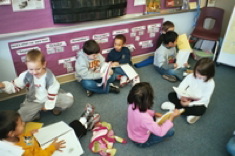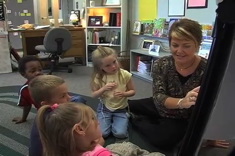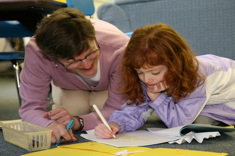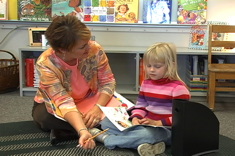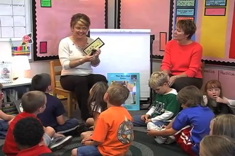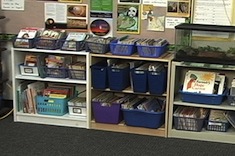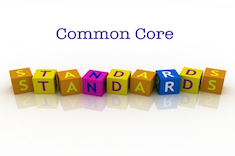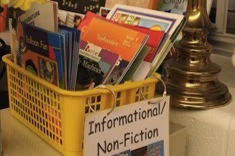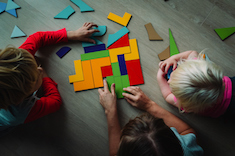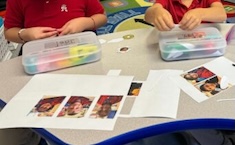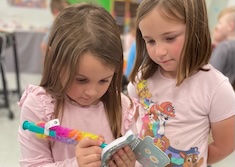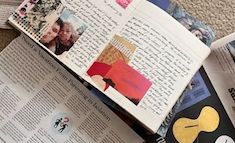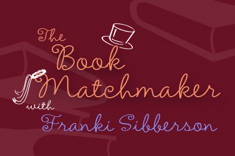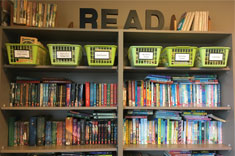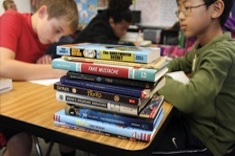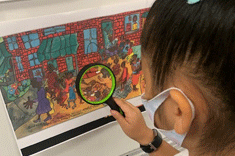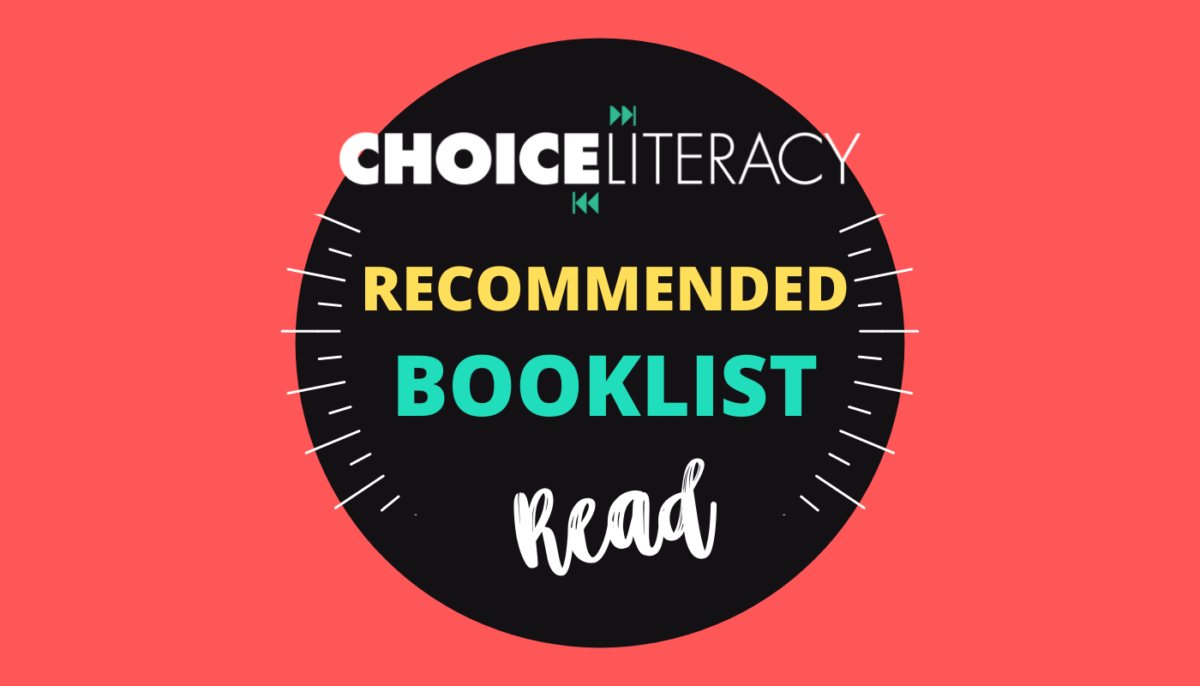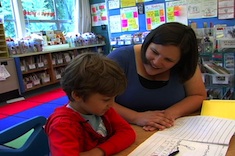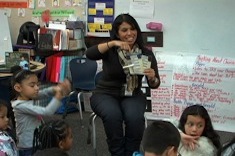1st
Latest Content
Shopping With Ana: Expanding Our Definition of “Just Right” Books in Grades K-2
Franki Sibberson learns from her daughter about emerging readers and book choice.
Mix It Up: Helping Young Writers Learn to Confer with Peers and Teachers
Ruth Shagoury models her own writing as a way to introduce the concept of conferring to young learners.
Flexible Groups: Moving Beyond Levels to Assess Reading Needs
Gail Boushey and Joan Moser (“The Sisters”) discuss how their thinking has evolved when it comes to flexible groups. The article includes a video excerpt of Joan working with a group of kindergartners.
The Lines are to Write My Words: Phonics in Context
Ruth Shagoury considers the role of phonics in context as she observes a classroom built on a foundation of children's expert knowledge as writers.
Planning for K-3 Author Studies (eGUIDE)
Gayle Brand knows the power of author studies and shares her activities, unit plans and year-long glances to support students identification as readers and writers.
My Son Clark Kent
Lisa Koch shares a parent's perspective of the damage too much emphasis on reading levels in the classroom does to her young son.
Small Group Instruction: Inferring Focus
In this example of reading instruction with a small group, Gail Boushey of “The Sisters” leads a discussion of inference, using Peter Rabbit as a focus text. All of the children in the group are reading at different levels independently, but they share a goal of learning more about inferring.
Noticing Words to Expand Vocabulary: Conferring with Mariah
In this conference with six-year-old Mariah, Joan Moser of “The Sisters” has chosen to focus on expanding vocabulary.
Whole-Class Vocabulary Lesson, Grades K-2
In this five-minute video, Joan Moser of “The Sisters” teaches a whole-class vocabulary lesson. The focus is on helping students notice interesting words, and make connections between daily read-alouds and word learning.
Coaching Moment: Reorganizing a Classroom Library
Gayle Gentry reflects on how a colleague’s simple request to reorganize a classroom library turned into coaching opportunities that had a direct impact on student learning.
Common Core Conversations: Increasing Argumentative Writing
Teachers continue to puzzle over and sort through the terminology in the Common Core related to opinion and persuasive writing. Amanda Adrian and Heather Rader consider terms and teaching strategies.
“I Am the Book”: Helping Emergent Bilingual Learners Connect with Books
Jesabel Centeno helps her emergent bilingual learners respond orally to texts and share favorite books with classmates.
Gratitude Week
Gigi McAllister shares the tradition of Gratitude Week. It gives students an authentic writing experience that has a ripple effect of spreading joy and gratitude throughout the school. It also shows them the significant impact that their words can have on others.
Use Math Practices to Deepen Friendships
Molly James is inspired by the book Friends Beyond Measure to use math practices to strengthen the bonds of friendship in her kindergarten classroom.
Going Deeper with Math Curricular Materials
Mallory Messenger guides us in taking what our district-adopted math curriculum resources provide and planning small changes by using problem stems and student problem posing to increase the rigor and make mathematical experiences accessible for all students.
Searching for Patterns with First Graders
Mallory Messenger leads us through a process to help first-grade students discover patterns by leaving the middle of an equation open. Mallory offers resources and student work to help every teacher see the possibility of giving students opportunities to make sense of math.
Jose the Late Bloomer
Stella Villalba has practical advice for reaching a young English language learner who is reluctant to write and often frustrated.
Photo Booth and Young Readers
Stella Villalba uses the Photo Booth app to build stamina in a young English language learner, as well as reinforce the learning and practice at home.
Using Me Boxes to Promote Identity, Academics, and Play
Tara Barnett and Kate Mills share a powerful (and simple) community activity. Students create their own Me Boxes to use (and update) throughout the school year to promote identity, academics, and play. Me Boxes originated from thinking about developmentally appropriate ways to build in work around identity in the classroom, as taught to us by Gholdy Muhammad in her book Cultivating Genius.
Play Is Powerful: Sharing Student Learning with Families
When kindergarten teacher Becca Burk overheard students’ parents comparing herself and a colleague, she reflected on the importance of play for young learners. In this article, Becca shares ways to communicate the power of play and students’ learning with families.
Writing as an Act of Resistance and a Source of Strength
In this beautiful personal essay, Stella Villalba reminds us that writing is a source of strength, and developing a community of writers is essential in post-pandemic classrooms.
Book Matchmaker: Read Alouds That Invite Young Readers to Participate
Franki Sibberson shares her latest suggestions for read alouds that invite participation from young readers.
Launching a Classroom Library
Melissa Styger slows down the launch of the classroom library to ensure it is a valuable resource all year.
Field Experience: Supporting Independent Reading, Choice and Stamina
Helping students learn to choose books and develop stamina are important to developing independent readers. Ruth Ayres designed a field experience with opportunities to see minilessons, small group instruction, team meetings and a share session that support independence in readers.
Trusting the Letting-Go Moments
Mandy Robek writes a powerful essay about giving her students more decision-making power in sharing their learning. In the release of letting go, she found ease in the joy of learning.
Nonfiction Books for Compassion, Inspiration, and Heart
Mandy Robek set out on a quest to discover new nonfiction books with characters who offer inspiration, compassion, and heart. Here are eight new titles you won’t want to miss.
Books That Sustain the Linguistic Lives of Multilingual Learners
We need more bilingual books! Stella Villalba explains why these books are essential and provides a booklist to help sustain the linguistic lives of multilingual learners.
Picture Books for Naming Emotions
Mandy Robek continues her series on picture books for understanding emotional turmoil in students. In this installment, she shares a list of books that can help children name emotions.
First-Grade Writing Conference: Celebrations to Suggestions
Katrina Edwards begins her conference with first grader Allen by celebrating all he is doing well in his writing. She highlights his language and details in writing, before moving on to new strategies to try.
Integrating Vocabulary and Retelling Strategies into Read-Aloud
Stella Villalba scaffolds the language development of her first- and second-grade English language learners during read-aloud by highlighting vocabulary and providing a tool to assist with a partner retelling activity.
Browse Content By
Type
Category
- Assessment Tools
- Big Fresh Archives
- Booklists
- Choice Numeracy
- Classroom Design
- Common Core
- Community Building
- Conferring
- Content Literacy
- Digital Literacy
- English Language Learners
- Equity
- Family Relations
- Free Samples
- Guiding Groups
- Leadership
- Literacy Coaches
- Mentor Texts
- Minilessons
- New Teacher Mentors
- Podcasts
- Poetry
- Quote Collections
- Reading Strategies
- Self Care
- Struggling and Striving Learners
- Talking and Listening
- Teacher Study Groups
- Teaching Reading
- Teaching Writing
- Word Study and Vocabulary
Author
- Melissa Quimby
- Nawal Qarooni
- Gwen Blumberg
- Julie Cox
- The Lead Learners
- Hannah Tills
- Josie Stewart
- Ruth Metcalfe
- Mallory Messenger
- Becca Burk
- Jodie Bailey
- Vivian Chen
- Mary Brower
- Tiffany Abbott Fuller
- Stephanie Affinito
- Ruth Ayres
- Leigh Anne Eck
- Heather Fisher
- Shari Frost
- Julie Johnson
- Suzy Kaback
- Gigi McAllister
- Shirl McPhillips
- Melanie Meehan
- Cathy Mere
- Debbie Miller
- Tara Barnett and Kate Mills
- Tammy Mulligan
- Dana Murphy
- Bitsy Parks
- David Pittman
- Brenda Power
- Heather Rader
- Matt Renwick
- Mandy Robek
- Christy Rush-Levine
- Gretchen Schroeder
- Jen Schwanke
- Brian Sepe
- Katherine Sokolowski
- Stella Villalba
- Jennifer Vincent
Grade Level
Choice Literacy Membership
Articles
Get full access to all Choice Literacy article content
Videos
Get full access to all Choice Literacy video content
Courses
Access Choice Literacy course curriculum and training


